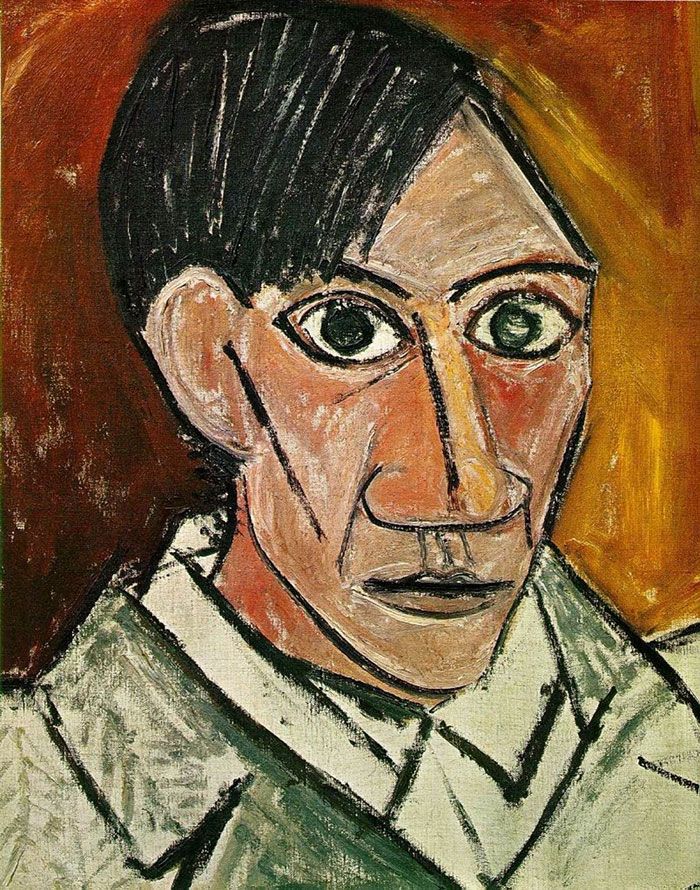The actual founder of cubism was the Spanish artist Pablo Picasso (b. 1881), follower of Paul Cézanne, the great French Post- Impressionist, and Georges Braque was a close runner-up of Picasso. Cézanne had formulated the theory that everything in nature is modelled on the sphere, the cone, and the cylinder: one must first understand how to paint these simple figures, and one can then paint anything’. The discovery of comparable essentials of form in negro and primitive art had a reinforcing influence.
The Cubist makes no attempt to give an exact reproduction of any objects visualized, but seeks to interpret in his own way the structure underlying surface appearance.
Cubism was considered the most influential movement of the century, led by artists Pablo Picasso and Georges Braque.The beginning of the movement happened with a painting of Picasso, that took the name of “Les demoiselles d’Avignon”.
The main purpose of the movement was the use of geometric forms for the creation of art, trying to represent the objects of the scene with them. It was one of the main artistic movements not to connect so much to reality or aesthetics and give preference to something more abstract, imaginary and surreal.
10 Characteristics of Cubism
The main features of the Cubism movement are:
- Use geometric shapes in your works
- Decompose images in geometric shapes
- Use of collages to give a new meaning and meaning to some image
- Do not use perspective, causing the sensation of a ‘sculptural’ painting
- Using darker, closed colors
- Use color on flat surfaces
- Give a feeling of a three-dimensional figure
- Using metal to express ideas
- Greater use of abstract
Stages of Cubism
Cubism was divided into three phases during the years of its rise: the Czannian, analytic and synetic.
The Cézanne took place between 1907 and 1909. As you can imagine by the name, Paul Cézanne was one of the great inspirations for Cubism during this period, as well as drawing inspiration from African works. The period is also called “pre-analytic” or early phase.
The analytic occurred between 1910 and 1912. It was the height of cubism and what was more ‘difficult’ to have a greater interpretation of the works, because they were very abstract and with much use of geometric forms.
Finally, the synthetic occurred between 1913 and 1914. During this period the collage had a great presence in Cubism, occurring several reconstructions of images, giving new meanings to them. During this time, the abstract was a bit smaller, with more chances for interpretation
Painters of Cubism
The main names of cubist paintings are:
- Pablo Picasso (Spanish)
- Paul Cézanne (French)
- Marcel Duchamp (French)
- Georges Braque (French)
- Fernand Léger (French)
- Umberto Boccioni (Italian)
- Diego Rivera (Mexican)
- Alexandra Nechita (Romanian)
Sculptors of cubism
The main names of cubist sculptures are:
- Pablo Picasso (Spanish)
- Marcel Duchamp (French)
- Georges Braque (French)
- Umberto Boccioni (Italian)
- Julio González (Spanish)
- Jacques Lipchitz (Lithuanian)
- Juan Gris (French)
Writers of Cubism
The main names of Cubist writings are:
- Érico Veríssimo (Brazilian)
- John of the Steps (American)
- Guillaume Apollinaire (French)
- Jean Cocteau (French)
- Oswald de Andrade (Brazilian)
Cubism is a revolutionary art movement that emerged in the early 20th century, primarily led by Pablo Picasso and Georges Braque. It’s known for its radical approach to traditional art, where objects are broken up, analyzed, and reassembled in abstracted form. To understand Cubism more clearly, let’s break it down into key elements and features in a tabular format:
| Element | Description |
|---|---|
| Perspective | Cubism abandons the traditional single viewpoint. Instead, it shows multiple perspectives of the same subject simultaneously, giving a more complete view. |
| Geometry | Objects and figures are broken down into geometric shapes like cubes, hence the name ‘Cubism.’ This fragmentation is a hallmark of the style. |
| Representation | Cubism is more about representing the essence of objects rather than depicting them realistically. It’s a move towards abstraction. |
| Time and Space | Cubism plays with the notion of time and space, showing different angles and perspectives as if they were happening at the same time. |
| Color Palette | Early Cubism (Analytical Cubism) often used muted, monochromatic colors. Synthetic Cubism introduced brighter colors. |
| Texture and Pattern | Cubists often used mixed media and introduced different textures and patterns into their work. Collage elements were also a part of Synthetic Cubism. |
| Subject Matter | Common subjects included still lifes, landscapes, and figures. However, these were not depicted in a traditional manner but rather in a fragmented, abstracted style. |
| Influence | Cubism was influenced by African art and Iberian sculpture, as well as by the work of Paul Cézanne, who explored geometric simplification in his work. |
Cubism was more than just a style; it was a philosophical approach to seeing the world in a way that challenged the conventional methods of representation in art. It paved the way for many abstract art movements that followed.
